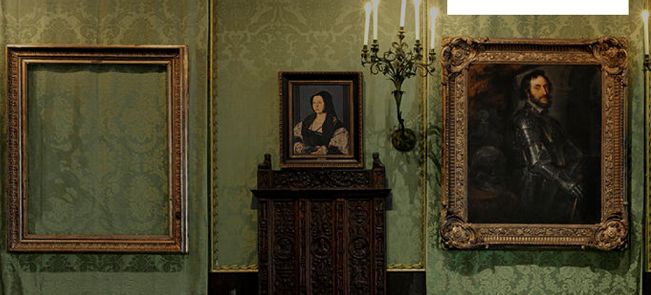
Courtesy of the gardnergallery.org
One of the most famous galleries in Boston, the Isabella Stewart Gardner Museum, attracts visitors to its rooms as much to see the empty frames hanging on its walls as the actual collection. Those hollow squares provide silent testimony to the world’s most famous and costly art theft, a loss of approximately $500 million. Stolen on St. Patrick’s Day in 1990, the burglary, conducted by men in police uniforms, carted away works by Rembrandt, Vermeer, and Degas, to name a few. Inexplicably, the museum’s most costly piece, Titian’s Rape of Europa was left behind. (The Case of the Empty Frames,” by Claire Suddath, Bloomberg Businessweek, July 6, 2020, pgs. 45-51.)
Though the statute of limitations has expired on the crime, sleuths continue to hunt for the loot simply because it was a baffling snatch, with no clues pointing to anyone, and without a whisper of the collection’s whereabouts. Solving the mystery would be lucrative and feather in someone’s cap.
Those empty frames hanging on the walls also speak to the strict provisions of Isabella Stewart Gardner’s will. None of the artwork can be moved, sold or donated. Any violation of these terms makes her possessions, which consists of the house and grounds as well as the exhibits, the property of Harvard University. As there was no provision pertaining to theft, the frames remain as they are to comply with the will and avoid the transfer of property.
In the slight hope the original works may find their way home, the museum has offered a $10 million reward– with no questions asked–for the return of the stolen pieces. Hope grows dim, however. Thirty years have passed and no one has claimed the prize.
I visited Isabella Stewart Gardner’s home in the 1970s, well before the heist. The building is a copy of a 15th century Venetian Palazzo with airy rooms and flooded with light, making it seem as if a master gem cutter had chiseled a perfect setting for each jewel. My afternoon wandering from place to place was memorable, and like the curators, I hope the lost paintings will find their way home, one day. In the meantime, all of us who treasure art, are left with more than one mystery. Why have none of the pieces surfaced either on the legal or black market? Who benefitted by this theft? And, where are these treasures hidden?
What isn’t a mystery is the passion to own a priceless artwork. If I could steal Rembrandt’s Return of the Prodigal from the Hermitage with success, would I? Or, Edvard Munch’s The Sick Child from the Tate? Or Vincent Van Gogh’s Starry Night from the walls of the New York Museum of Modern Art?
I also understand why Isabella put such stringent restrictions on her collection. My own is not grand, though I possess a reinterpretation of Van Gogh’s Stary Nigh, and Wheatfield with Crows. I obtained it from a talented young artist decades ago. The style isn’t similar, merely reminiscent, and yet it has its own integrity, I think. Having grown more and more fond of it over these many years, I almost prefer my piece to the masterwork.
That’s where obsession lies, of course. Pieces I’ve collected reflect some aspect of my life. It pains me, as it must have done Isabella with regard to her possessions, to think of mine dispersed to the four winds upon my death, some of them, perhaps, left to collect dust in a forgotten corner of Good Will.
Even so, I’m old enough to know, we humans have no claim to anything, not even the vital air we breathe. We are temporary caretakers of the treasures we’ve grown to love.
Isabella should have considered her impermanence before placing such stringent restrictions on her collection. If she had, her museum wouldn’t be frozen in time, its wallpaper masquerading as art behind empty frames.
